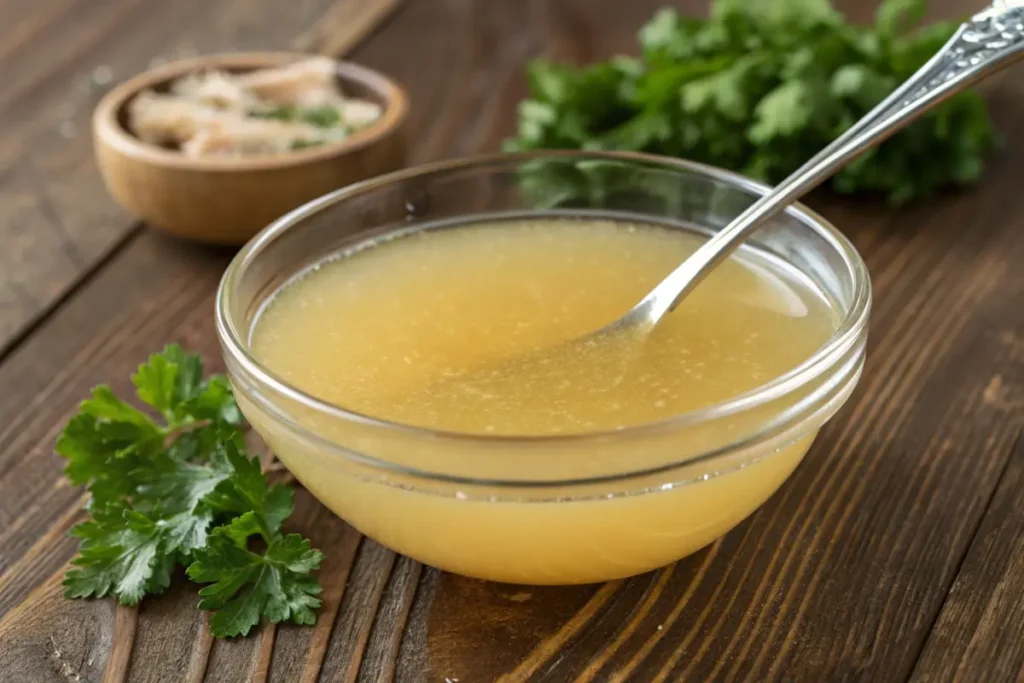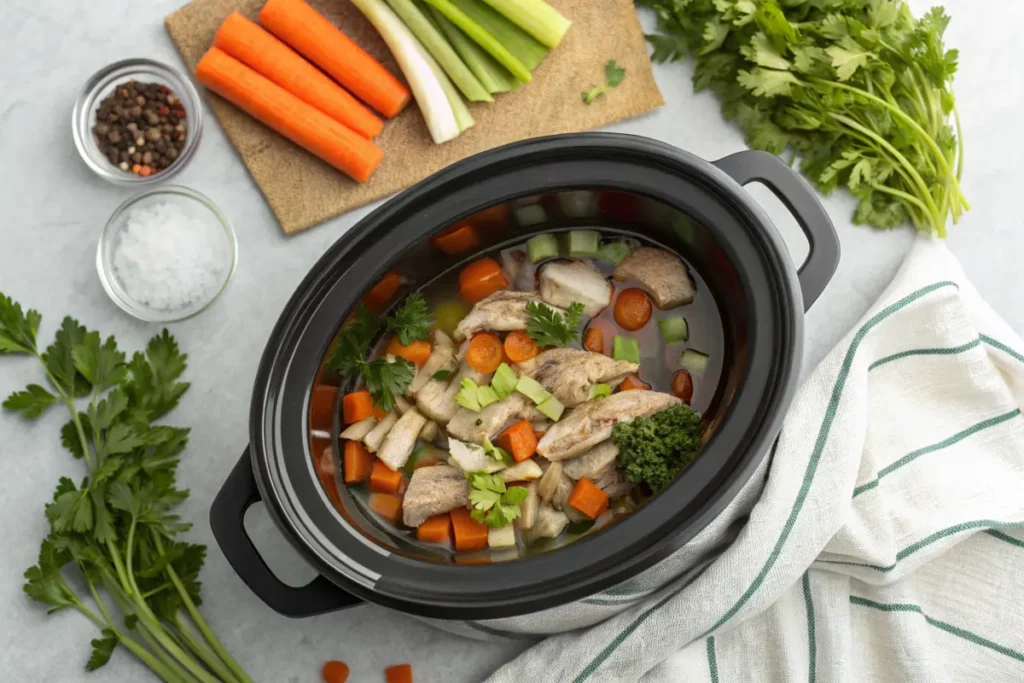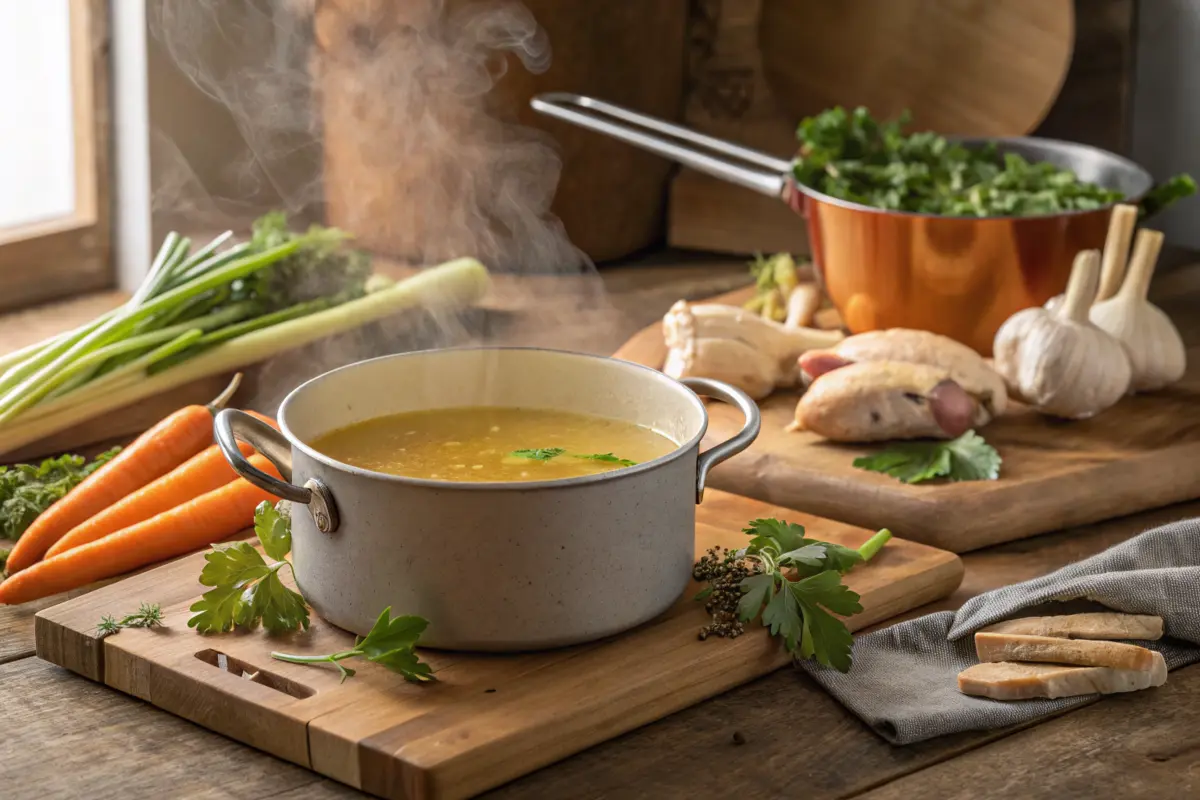Bone broth has stood the test of time, lauded as a comforting elixir packed with nutrients and flavor. Whether you’re a home chef or just dipping your toes into the world of culinary arts, mastering a chicken bone broth recipe can transform your kitchen skills and boost your health. This guide will walk you through everything you need to know about making the perfect chicken bone broth, from selecting the best ingredients to troubleshooting common mistakes.
Let’s dive in and uncover the secrets behind this wholesome kitchen staple!
Introduction to Chicken Bone Broth
What Is Chicken Bone Broth?
Chicken bone broth is a savory, nutrient-rich liquid made by simmering chicken bones with water, vegetables, and seasonings. Unlike regular chicken broth or stock, bone broth is simmered for an extended time—typically 12 to 24 hours—to extract collagen, minerals, and other healthful compounds. The result? A flavorful base that’s both delicious and versatile.
Health Benefits of Chicken Bone Broth
This liquid gold isn’t just tasty; it’s a powerhouse of nutrients. Packed with collagen, amino acids like glycine and proline, and essential minerals like calcium and magnesium, bone broth supports joint health, promotes gut healing, and improves skin elasticity. It’s also known for its ability to boost the immune system and aid in recovery during illness.
- Gut health and digestion: The gelatin in bone broth helps seal the gut lining, improving digestion.
- Joint and bone support: Rich in collagen, it strengthens connective tissues and bones.
- Skin and hair benefits: It’s a natural beauty booster, thanks to collagen and elastin.
Why It’s a Staple in Many Kitchens
Bone broth is versatile enough to elevate any recipe, from soups and stews to risottos and sauces. Moreover, it’s an excellent way to minimize kitchen waste—those leftover chicken carcasses and vegetable scraps? They’re perfect for broth-making! Beyond its practical uses, the comforting aroma of simmering broth can make your kitchen feel like a sanctuary.
Ingredients and Equipment for Chicken Bone Broth
Essential Ingredients for the Perfect Broth

Creating a delicious and nutrient-packed chicken bone broth recipe starts with the right ingredients. Here’s what you’ll need:
- Chicken Bones: Use a mix of leftover carcasses, wings, feet, or necks for maximum collagen extraction.
- Vegetables: Add onions, carrots, and celery for a classic mirepoix flavor base.
- Vinegar: A splash of apple cider vinegar helps draw minerals from the bones.
- Herbs and Spices: Bay leaves, parsley, and thyme add depth, while black peppercorns give a gentle kick.
- Water: Filtered water ensures a clean, pure flavor.
Optional Add-ins for Flavor and Nutrition
Take your broth to the next level with these optional additions:
- Garlic and Ginger: Boost immune support and add zest.
- Turmeric: Infuse anti-inflammatory properties and a golden hue.
- Seaweed: Enhance iodine and nutrient content for thyroid health.
Tools You’ll Need for Cooking and Storing
Equip yourself with these tools to make the process seamless:
- Stockpot or Slow Cooker: Ideal for long, slow simmering.
- Strainer or Cheesecloth: Essential for removing solids after cooking.
- Airtight Containers: Use for freezing or refrigerating your broth.
For more tips on repurposing leftover ingredients, check out this article on creative rotisserie chicken recipes.
Step-by-Step Guide to Making Chicken Bone Broth
Preparing the Chicken Bones
Start by gathering your chicken bones. If using raw bones, roast them in the oven at 400°F for 30 minutes to enhance flavor. If you’re using leftovers, ensure they’re clean of excess meat or skin.
Stovetop Method Explained
- Place bones, vegetables, and vinegar in a large stockpot.
- Add water, ensuring all ingredients are submerged.
- Bring to a boil, then reduce to a gentle simmer.
- Skim off foam and impurities during the first hour.
- Cover and simmer for 12–24 hours.
- Strain the broth using a fine-mesh strainer.
Slow Cooker Method: Set It and Forget It

- Combine all ingredients in your slow cooker.
- Set to low and cook for 18–24 hours.
- Skim impurities occasionally, then strain and store.
Instant Pot Method for Quick Results
Pressed for time? The Instant Pot delivers rich chicken bone broth in just a few hours:
- Add ingredients to the pot, ensuring you don’t exceed the max fill line.
- Seal the lid and set to high pressure for 2 hours.
- Allow for natural pressure release, then strain and store.
Making broth is as much about the journey as the destination. Whether you choose the stovetop, slow cooker, or Instant Pot, each method yields a warm, nutrient-rich elixir perfect for sipping or cooking.
Variations and Customizations
Herb and Spice Combinations for Unique Flavors
Elevate your chicken bone broth recipe by experimenting with different herb and spice blends:
- Mediterranean Twist: Add rosemary, oregano, and a hint of lemon zest for a fresh, aromatic flavor.
- Asian Fusion: Toss in lemongrass, star anise, and soy sauce to create a broth with depth and warmth.
- Spicy Kick: Sprinkle in red pepper flakes or jalapeños for those who love heat.
Vegetarian Alternatives and Adaptations
While traditional bone broth relies on chicken bones, you can create a flavorful vegetarian version:
- Swap Bones for Vegetables: Use mushrooms, seaweed, and nutritional yeast to mimic the umami of bone broth.
- Add Protein-Rich Legumes: Lentils or chickpeas can enrich your broth’s nutritional profile.
Low-Sodium and High-Protein Variants
Customizing your broth for dietary needs is simple:
- Low-Sodium Option: Skip added salt and use herbs for flavor.
- High-Protein Broth: Add collagen powder or simmer extra chicken feet to boost protein levels.
If you’re looking for more creative ways to customize recipes, visit Recipe Foodies for inspiration.
Storing and Using Your Chicken Bone Broth
Best Practices for Storage: Freezing and Refrigeration
Proper storage ensures your broth stays fresh and flavorful:
- Refrigeration: Store broth in airtight containers for up to 5 days.
- Freezing: Pour broth into silicone molds or freezer-safe bags for longer storage—up to 6 months.
Pro Tip: Label containers with the date to avoid second-guessing freshness.
Creative Ways to Use Chicken Bone Broth in Recipes
This chicken bone broth recipe isn’t just for sipping! Use it to:
- Enhance Soups and Stews: Replace water with broth for a richer flavor.
- Cook Grains: Boil rice, quinoa, or pasta in broth for added nutrients.
- Make Sauces: Use broth as a base for gravies or pan sauces.
For a hearty meal idea, try pairing your broth with dishes like chicken and potatoes recipes for a comforting, nutrient-packed dinner.
How Long Does Bone Broth Last?
Bone broth’s longevity depends on storage:
- Refrigerated broth lasts 3–5 days.
- Frozen broth retains its quality for up to 6 months.
To keep your broth safe, always reheat it to a rolling boil before consuming.
For more recipe storage tips, check out our guide on how to store leftovers efficiently.
Common Mistakes and Troubleshooting Tips
Why Your Broth May Not Gel and How to Fix It
One hallmark of a great chicken bone broth recipe is its gel-like consistency when cooled, thanks to collagen. If your broth doesn’t gel, don’t worry—here’s how to fix it:
- Insufficient Collagen-Rich Bones: Use feet, wings, or necks to boost gelatin.
- Too Much Water: Keep the water level just above the bones to concentrate the collagen.
- Short Simmering Time: Let your broth simmer for at least 12 hours for full extraction.
While a non-gelling broth is still nutritious and tasty, these tips can help you achieve the perfect texture.
Avoiding Bitter Flavors in Broth
Bitterness can sometimes creep into your broth. To prevent this:
- Avoid Overcooking Vegetables: Remove them after the first 4–6 hours.
- Use Fresh Ingredients: Old or wilted veggies can impart unwanted flavors.
- Skim Impurities: Regularly skim off foam and scum during cooking.
Preventing Cloudy Broth: Tips for Clarity
If clarity matters to you:
- Use Cold Water: Start with cold water to prevent emulsifying fats.
- Don’t Boil Too Hard: Keep the broth at a gentle simmer.
- Strain with Cheesecloth: For a crystal-clear finish, strain the broth twice.
FAQs About Chicken Bone Broth
What Are the Key Differences Between Broth, Stock, and Bone Broth?
Though the terms are often used interchangeably, they’re distinct:
- Broth: Made with meat and simmered for a few hours, it’s lighter and less rich.
- Stock: Made from bones and cooked longer, resulting in a more robust base.
- Bone Broth: A combination of bones, water, and vinegar, simmered for 12–24 hours to extract maximum nutrients.
If you’re new to cooking with broth, this chicken bone broth recipe is a great starting point.
Can You Use Leftover Rotisserie Chicken for Bone Broth?
Absolutely! Rotisserie chicken bones are perfect for making bone broth. They’re already roasted, which enhances the flavor. Simply follow the recipe and enjoy a zero-waste approach.
How Often Should You Consume Chicken Bone Broth?
Bone broth can be enjoyed daily or as needed. Many people drink it as a morning boost or as a comforting evening snack. Its nutrient-rich profile supports gut health, joint mobility, and overall wellness.
Is Bone Broth Safe for Pets?
Yes, bone broth can be a nutritious treat for pets. However, ensure it’s free of onions, garlic, and excess salt, which can be harmful. Offer it as a topper for their regular meals or a standalone snack.
Frequently Asked Questions About Chicken Bone Broth Recipe
Why Is Chicken Bone Broth Considered a Superfood?
Chicken bone broth is often referred to as a superfood because of its dense nutrient profile. It’s packed with collagen, amino acids, and essential minerals that support gut health, joint mobility, and skin elasticity. Plus, it’s easy to digest, making it a go-to remedy for those recovering from illness.
Can I Make Chicken Bone Broth Without Vinegar?
Yes, you can skip the vinegar, but it plays a crucial role in drawing minerals from the bones. If you prefer, substitute vinegar with lemon juice or another acidic ingredient to achieve similar results. For a truly customizable chicken bone broth recipe, feel free to adapt based on your preferences.
How Do I Make Bone Broth Taste Better?
To enhance the flavor of your broth:
- Use fresh, high-quality ingredients.
- Add herbs and spices like rosemary, thyme, or bay leaves.
- Simmer the broth longer to deepen the taste.
If you’re looking for inspiration, check out other comforting recipes to pair with your broth.
What’s the Best Way to Reheat Chicken Bone Broth?
Reheating is simple:
- Stovetop: Warm the broth on low heat to preserve its nutrients.
- Microwave: Use short bursts of 30 seconds to avoid overheating.
Always ensure the broth reaches a safe temperature before consuming.
Concluding Thoughts on Chicken Bone Broth Recipe
Chicken bone broth is more than just a kitchen staple—it’s a symbol of warmth, comfort, and wellness. Whether you’re sipping it on a chilly evening or using it as a base for hearty soups, this versatile recipe offers both flavor and nourishment. By customizing it to suit your taste and dietary needs, you can enjoy the benefits of this timeless tradition.
The beauty of a chicken bone broth recipe lies in its simplicity. With just a few basic ingredients, you can create a rich, nutrient-packed broth that elevates any dish. Plus, the process itself—whether simmering on the stovetop or letting the slow cooker work its magic—fills your home with a cozy aroma.
For those new to bone broth or seasoned experts looking to refine their methods, this guide offers a roadmap to perfecting your own recipe. Experiment with flavors, learn from missteps, and most importantly, savor the results.
For more ideas on incorporating broth into your meals, visit Recipe Foodies. Here’s to making chicken bone broth a cherished part of your culinary routine!

